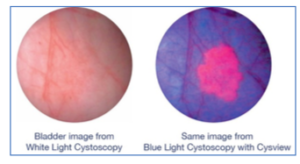Blue Light Cystoscopy (BLC® ) with Cysview®
Bladder cancer is a growing concern in our community, our nation, and the world. We know you care about your patients as much as we do. That’s why we wanted to let you know this important information for our community.
HCMC’s Kentucky Lake Urologic Associates now offers Blue Light Cystoscopy with Cysview® for improved detection and management of non- muscle invasive bladder cancer.
You may not know about this procedure, so we’ve included some key facts about it below. We hope you will think of Kentucky Lake Urologic Associates when you have patients who may need bladder cancer diagnosis, treatment or care.
Bladder cancer statistics
- More than 700,000 people living with bladder cancer in the U.S. (1)
- Approximately 80,000 people are diagnosed each year (2)
- It’s the 3rd most common cancer in U.S. (men2)
- It’s the 9th most common cancer in U.S. (women2)
Download the Bladder Cancer Fact Sheet
About Blue Light Cystoscopy (BLC®) with Cysview
During a standard cystoscopy procedure, a healthcare professional looks into the bladder using regular white light. During a Blue Light Cystoscopy, the HCP uses both white and blue light. However, the blue light is only effective if Cysview has been instilled in the patient’s bladder at least one hour before the procedure.
Cysview® (hexaminolevulinate HCl) is the only FDA-approved agent for use in Blue Light Cystoscopy. It is an optical imaging agent indicated for the detection of non-muscle invasive bladder cancer, including carcinoma in situ (CIS), in patients:
- suspected or known to have lesion(s) based on a prior cystoscopy or
- undergoing surveillance cystoscopy for carcinoma of the bladder.
Cysview makes tumor cells glow bright pink in blue light, but it is not a dye. It is a variant of a naturally occurring molecule in the body that results in increased production of another natural compound. Unhealthy cells do not process out the compound as quickly as healthy cells; the resulting accumulation creates a pink glow in blue light.

During a standard cystoscopy procedure, a healthcare professional examines the bladder using regular white light. During a Blue Light Cystoscopy, the HCP uses both white and blue light. However, the blue light is only effective if Cysview has been instilled in the patient’s bladder at least one hour before the procedure.
In the US, Cysview is indicated for use only with the KARL STORZ D-Light C Photodynamic Diagnostic (PDD) system. Globally, hexaminolevulinate HCl has been used in more than a half-million patients.
The 2016 AUA/SUO NMIBC Guideline states: “In a patient with non-muscle invasive bladder cancer (NMIBC), a clinician should offer blue light cystoscopy at the time of TURBT, if available, to increase detection and decrease recurrence. (Moderate Recommendation; Evidence Strength: Grade B)
References: 1. National Cancer Institute. SEER Stat Facts: Bladder Cancer 2017. https://seer.cancer.gov/statfacts/html/urinb.html. Accessed January 25, 2019. 2. Globocan. Incidence/mortality by population. Available at: http://globocan.iarc.fr/Pages/bar_pop_sel.aspx https://gco.iarc.fr/today/data/factsheets/populations/840-united-states-of-america-fact-sheets.pdf. 3. Cysview [prescribing information]. 2018:1-14. 4. Chang SS, Boorjian SA, Chou R, et al. Diagnosis and Treatment of Non-Muscle Invasive Bladder Cancer: AUA/SUO Guideline. J Urol. 2016;196(4):1021-1029.











